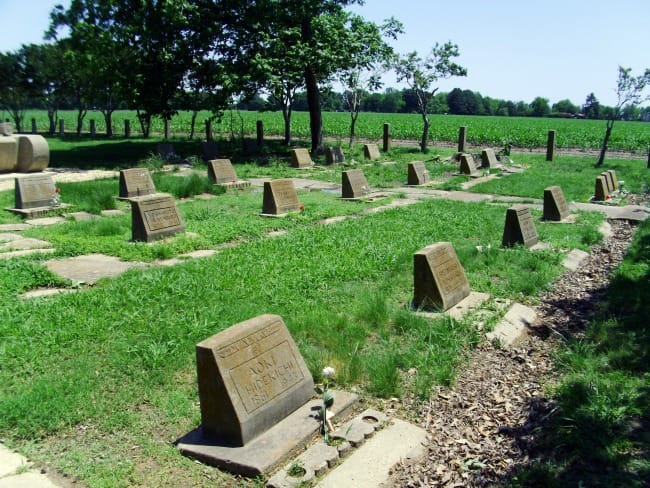

Uh oh...
It appears that you're using a severely outdated version of Safari on Windows. Many features won't work correctly, and functionality can't be guaranteed. Please try viewing this website in Edge, Mozilla, Chrome, or another modern browser. Sorry for any inconvenience this may have caused!
Read More about this safari issue.

Downtown streets, country lanes, and sometimes even our own backyards are home to unique structures and places from another era in Arkansas history. Each year, Preserve Arkansas publishes a list of the state’s Most Endangered Places after a public nomination period. This year’s list includes “Seven to Save” properties around the state. Read more in our previous posts.
Another one of these properties is a beloved building in Clarksville.
Clarksville National Guard Armory
The Clarksville National Guard Armory building is a sturdy two-story red brick structure built in 1930 to house National Guard companies in Johnson County. The building was funded by a statewide armory building program that created 17 armories across the state. The Clarksville Armory was constructed on land originally owned by the University of the Ozarks, sold to the city, and then to the Arkansas National Guard, for $1. The plans for the building included a gymnasium that could hold 1,000 fans for high school and college basketball games.

Once completed, the National Guard used the building for 48 years before returning the armory to the city of Clarksville. The city turned the armory into the Sonny Alston Youth Center, named after a local city employee with a passion for youth sports. Many of Clarksville’s citizens cherish memories of basketball games, volleyball, youth boxing, school programs and dances held inside the center. You only have to read a few comments on the online petition to see how well-loved the building is.
Unfortunately, the building is deteriorating, as many of the historic properties on the Most Endangered List are, and if the armory is to be saved, it must happen soon. Residents in Clarksville are rallying around the armory, pledging support through an online petition and hoping the city will find a way to work with Preserve Arkansas and concerned citizens to refurbish the armory and continue to provide a place for those in Clarksville to enjoy for years to come. You can keep up with the efforts to save the Clarksville armory at SaveOurArmory.org.
John L. Webb House
In 2014, Preserve Arkansas named the John L. Webb House in Hot Springs to its 2014 “Fragile Five” list of Most Endangered Places. If you’ve ever visited Hot Springs and walked down Pleasant Street, you’ll recognize the Webb House immediately. Its red brick veneer and green tiled roof draw the eye to it, not to mention the multiple gables, large front porch and beautiful rounded tower, all products of its Queen Anne style design.

The house belonged to Hot Springs resident John Lee Webb, a prominent African-American citizen who was active in many civic organizations. A carpenter and builder, he purchased the home in 1920 and added the eye-catching red and green veneer and roof. Webb died in 1946, leaving a lasting legacy in the city of Hot Springs through his community work. The house was vacant and in disrepair when Preserve Arkansas chose it for the 2014 list.
Since that time, a true community effort has emerged to save the John L. Webb house. P.H.O.E.B.E. (People Helping Others Excel by Example), a local non-profit organization dedicated to preserving the history of African-American in Hot Springs, is leading the charge to save this unique property and turn it into a museum and the cornerstone of the revitalization of Pleasant Street, once the hub of the African-American community in Hot Springs. The organization plans to restore the home in three phases and establish a museum centered around the city’s African-American history. Keep up with efforts to restore this endangered home on the Save the John Lee Webb House Facebook page.
Rohwer Relocation Center
For many years, an important part of Arkansas’s World War II history was quietly ignored. From 1942-1945, two Japanese Internment Camps held a total of 16,000 Japanese immigrants and Japanese-American citizens behind barbed wire and under military guard, part of the forced removal of 120,000 Japanese from the West Coast.
When President Franklin D. Roosevelt created the War Relocation Authority in 1942, forced removal began immediately as Japanese immigrants and citizens were rounded up in California, Oregon and Washington, placed on trains, and shipped to ten different camps hurriedly constructed to detain the Japanese for the duration of the war. Two locations in southern Arkansas were chosen, Rohwer and Jerome, because of their remoteness, farmable land and access to a railroad.

Formerly marshy Delta land became the site of tar-papered barracks, a school house, a hospital, community spaces and administration buildings. Guard towers were built around the camp and barbed wire surrounded the entire space, effectively sealing the Japanese into their internment. Over the span of three years, a handful of citizens were approved to leave, but most lived in the camps until they were released in 1945. The Rohwer Relocation Center was one of the last camps to close.
After the war, the land was returned to area farmers or abandoned and the buildings were used for farming and later torn down. When Preserve Arkansas listed the Rohwer and Jerome Japanese-American Relocation Camps in the 2010 “Nine in Need” Most Endangered Places list, little remained of either site, ownership was murky and forest and farming were rapidly obscuring the sites and threatening to ensure the camps disappeared in Arkansas history.
In 2013, the Japanese-American Internment Museum opened in the McGehee Railroad Depot. The museum is part of Arkansas State University’s Heritage Sites and seeks to preserve the stories and history of Japanese-Americans housed at nearby Rohwer and Jerome Relocation Centers. The Heritage Sites program also took on the responsibility of interpreting the Rohwer site through a grant from the National Park Service. Although only the cemetery and one smokestack remain of the original site, visitors can now visit a replica of a guard tower and take a self-guided tour along the camp boundary, following informational signs.

In April 2013, actor George Takei returned to the place where he was lived as a boy to dedicate the heritage site and the two monuments that acknowledge and honor those that died while in the relocation centers, and the Japanese-American soldiers who fought and died in the war while their families were being held in the centers. From 2010, when the Japanese-American Relocation Centers were in danger of being scrubbed from history, to today, this is the kind of change and protection Preserve Arkansas hopes for each time they create Arkansas’s Most Endangered Places list.
Nominations for the 2017 Most Endangered Places will open early in 2017. If you’re interested in nominating a property, visit preservearkansas.org to learn more and become involved in preserving Arkansas history.

Photos courtesy of Preserve Arkansas and used with permission.
Rohwer Cemetery Photo by Brandonrush
Join the Conversation
Leave a Comment
One response to “Arkansas’s Most Endangered Places – Part 4”
 Leave a Reply
Leave a Reply
We do the work.
You check your email.
Sign up for our weekly e-news.
Get stories sent straight to your inbox!










 Leave a Reply
Leave a Reply
[…] thousands other Japanese-Americans were forcibly relocated from their homes to internment camps. Two of these camps, Rohwer and Jerome, were built in Arkansas. Takei, a child at the time, was sent with his family to Rohwer, an experience he relates on an […]